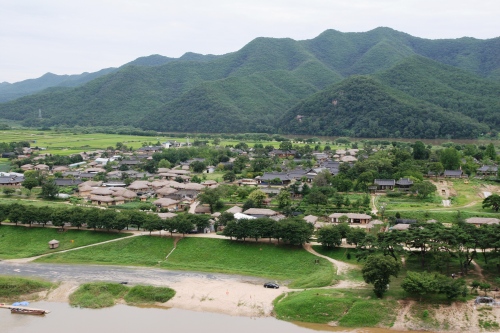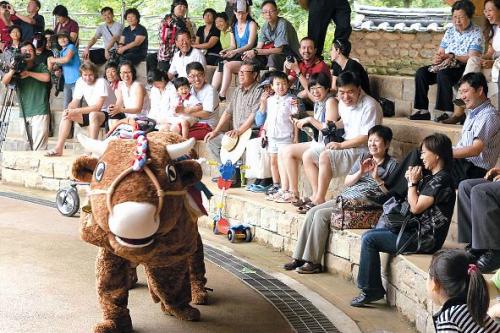World Heritage site Hahoe Village keeps Confucian traditions alive
ByPublished : Sept. 17, 2010 - 18:54
ANDONG, North Gyeongsang Province To a background of sharp music, masked commoners let out the inner anger and sadness they have suppressed serving the noblemen through satirical words and acting.
The mask dance drama, Hahoe Byeolsingut Talnori, was the only way Korean commoners could get even with the nobility in the rigid class society of the Joseon Dynasty (1392-1910).
“I’ve never seen a nobleman and a scholar fight over a cow’s testicles to get healthy in my entire life. Isn’t it funny?” shouts an 80-year-old grandma to the audience during the show.
The mask dance drama, Hahoe Byeolsingut Talnori, was the only way Korean commoners could get even with the nobility in the rigid class society of the Joseon Dynasty (1392-1910).
“I’ve never seen a nobleman and a scholar fight over a cow’s testicles to get healthy in my entire life. Isn’t it funny?” shouts an 80-year-old grandma to the audience during the show.

The spectators laugh out loud when a cow urinates at them.
In the final act of five characters dancing together, actors invite Korean and foreign tourists to the stage to join in the dance.
Even though there is no screen with foreign-language subtitles to help tourists understand what the actors are saying, they seemed to have got the gist of the satire just by watching the wildly exaggerated acting.
“It was quite fun and I could guess what was going on,” said 30-year-old Spanish tourist Veronica Gallego, who danced with the actors.
The tradition of masked-dance drama almost came to an end in 1928 under Japanese colonial rule as they attempted to annihilate Korean culture, according to Yim Hyeong-gyu, 58, who played the nobleman in the drama.
“When I was 20, in 1973, I joined the Andong Hahoe Mask Dance Institute to revive the Byeolsingut. But the conservative Andong people were mostly against the idea at the time,” he said.
Despite the difficulties, the Byeolsingut was designated by the government as an important intangible cultural asset in 1980.
The Hahoe Byeolsingut Talnori is a regular mask dance drama of the Hahoe Village, the most well-known historic clan village in Korea situated in Andong, North Gyeonggi Province. It is held at the Training Hall for the Inheritance of the Hahoe Byeolsingut Mask Dance Play, at the mouth of the Hahoe village, every Saturday and Sunday from May to October and every Sunday in March, April and November.
‘The whole Hahoe Village is an open museum’

Hahoe Village was added to the UNESCO’s World Heritage site on July 31 for its unique layout and location having forested mountains behind and facing out onto the Nakdong River and open agricultural fields plus its reflection of the distinctive aristocratic Confucian culture of the early Joseon era.
The village became internationally famous when Britain’s Queen Elizabeth II visited the village to celebrate her 73rd birthday and called it the most Korean traditional spot in the nation.
Now, Andong City is upping its promotion of Hahoe village on the back of the UNESCO designation.
“Although the addition of the village to the World Heritage site was 10th such site in Korea, it was the first time that a village was enlisted,” said Kwon Young-sae, Andong City mayor.
“As the village has centuries-old houses where people still keep their unique lifestyle, the entire village is an outdoor museum,” he said.
Hahoe, representing the single Yu clan for 600 years, has both tile-roofed and thatched-roofed houses nicely clustered together, with the S-shaped Nakdong River coursing around them.
In the middle of the village, a 600-year-old tree called Samsindang, stands on the highest point in the village. Around the tree hang numerous white notes left by visitors, wishing luck for their children.
About 1 million visitors come to Hahoe village each year and the number of visitors has increased around 1.5 times after the World Heritage listing, Kwon said.
With daily arrival in the village averaging around 5,000, Andong City limits entry if the number of visitors at the village exceeds 20,000 at any given time.
Most of the foreign visitors are Japanese, as they seemingly find comfort in the old houses and streets of the village, Kwon said.
The Andong International Mask Dance Festival, featuring both traditional Korean and international mask dance performances, will be held from Sept. 24 to Oct. 3. The festival includes a mask parade with participation of all visitors wearing masks. In the evening during the festival, the Hahoe Village will revive ancient-style poem writing, boat riding and a fire party called Seonyujulbul Nori, once enjoyed by the literati, or yangban.

Strolling inside the quiet Hahoe offers a chance to see how the yangban taught their teenage children, at Confucian schools called seowon.
One of the major seowon academies in Hahoe is Byeongsan Seowon, which was established in 1614 by Confucian scholars in tribute to Yu Seong-ryong, a prime minister of the Joseon Dynasty in the late 16th century. Yu was a follower of Yi Hwang, the prominent Neo-Confucian scholar, whose portrait now appears on the 1,000 won bill.
“The name Byeongsan comes from the description of how the academy was surrounded by wall-like mountains,” said tour guide Lee Jun-yong.
Great influence by Yi Hwang and Dosan Seowon
About an hour-drive northeast of Hahoe Village is Dosan Seowon, a private Confucian academy which was built in 1574 by disciples of Yi Hwang four years after he died.
Just like Byeongsan Seowon in Hahoe, the Confucian academy complex is also sheltered by a mountain and faces out onto the Nakdong River, following the rules of feng shui, or geomancy.
Also known by his pen name Toegye, Yi Hwang started to build Dosan Seodang or lecture hall, in 1549 after retirement for the purpose of education and commemoration of ancestors.
“Toegye wrote himself a signboard saying ‘Nongunjeongsa’ for the student dormitory, which still hangs here, to tell students to keep their integrity once they become government officials,” Lee said.
The sign board saying “Dosan Seowon,” hung in the main lecture hall Jeongyodang, was written by famous mid-Joseon calligrapher Han Seok-bong but the original signboard is preserved at the near-by Advancement Center for Korean Studies (ACKS) in Andong, he said.
Jangpangak, where about 3,000 wooden blocks were stored for reprints of works of Yi Hwang and King Seonjo, is now empty as the wooden blocks have been transferred to ACKS for safe keeping.
Wooden blocks hold history
A visit to the ACKS allows an in-dept look at how old clans in Andong stored wooden blocks to print books about their history.
The state-run research institute has collected about 60,000 wooden blocks from individual families in its own Jangpangak building over the past several years.
“If the number surpasses 80,000, we plan to enlist them on the UNESCO Memory of the World,” said Kwon Jin-ho, research director of wood-blocks at the ACKS.
Of the 60,000 wooden blocks stored here, 80 percent are from individual family’s collection of works and they are deemed to have been created from the 1560s until the 1930s, Kwon said.
“Considering that the yangban did not have much money and that the cost of making one wooden block was huge, it is amazing that they have kept this culture of keeping records for hundreds of years,” he said.
Even though the wooden blocks preserved at the ACKS are not open to the general public, a special group reservation for a brief look is possible by appointment.
The research institute also plans to open an exhibition next year of the original signboards, which were hung on the old houses of Hahoe and several seowon buildings.
“We cannot open the Jangpangak building to the public because there is a dam near here. Frequent fogs mean high levels of humidity might damage the blocks,” Kwon said.
To get to Andong from Seoul, it takes about three hours by bus and four and a half by train. For more information, call (054) 856-3013 or visit www.tourandong.com. For information about mask dance, visit www.maskdance.com.
By Kim Yoon-mi (yoonmi@heraldcorp.com)







![[From the Scene] Monks, Buddhists hail return of remains of Buddhas](http://res.heraldm.com/phpwas/restmb_idxmake.php?idx=644&simg=/content/image/2024/04/19/20240419050617_0.jpg&u=20240419175937)







![[From the Scene] Monks, Buddhists hail return of remains of Buddhas](http://res.heraldm.com/phpwas/restmb_idxmake.php?idx=652&simg=/content/image/2024/04/19/20240419050617_0.jpg&u=20240419175937)

![[KH Explains] Hyundai's full hybrid edge to pay off amid slow transition to pure EVs](http://res.heraldm.com/phpwas/restmb_idxmake.php?idx=652&simg=/content/image/2024/04/18/20240418050645_0.jpg&u=20240419100350)

![[Today’s K-pop] Illit drops debut single remix](http://res.heraldm.com/phpwas/restmb_idxmake.php?idx=642&simg=/content/image/2024/04/19/20240419050612_0.jpg&u=)